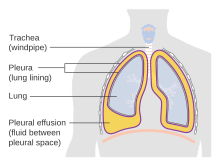| Pleural effusion | |
|---|---|
 | |
| Diagram of fluid buildup in the pleura | |
| Specialty | Pulmonology, thoracic surgery[1] |
| Symptoms | Chest pain, coughing, shortness of breath, none[2] |
| Types | Exudate (empyema, hemothorax, chylothorax), transudate[2] |
| Causes | Exudate: Inflammation, tumors, infections, injury to the lung[2] Transudate: Heart failure, kidney problems, liver failure, peritoneal dialysis, malnutrition[2] |
| Diagnostic method | Chest X-ray[1] |
| Differential diagnosis | Mesothelioma, heart failure, atelectasis, pneumonia, diaphragmatic rupture[1] |
| Treatment | Thoracentesis, underlying cause[1] |
| Frequency | 1.5 million (USA)[1] |
A pleural effusion is excess fluid in the pleural cavity, the space that surrounds the lungs.[1] Symptoms may vary from none to chest pain, coughing, and shortness of breath.[2] The shortness of breath may initially only be present with exercise.[1]
They are divided into two types exudates and transudates.[2] Exudates occur due to inflammation, tumors, infections, or injury to the lung.[2] Transudates occur due to heart failure, kidney problems, liver failure, peritoneal dialysis, or malnutrition.[2][1] Other causes may include pulmonary embolism, certain medications, following radiation therapy, or esophageal rupture.[1]
Diagnosis is generally confirmed by chest X-ray or ultrasound.[1] Thoracentesis to drain some of the fluid may be done to help determine the underlying cause and treat the condition.[1] Further treatment is than directed towards the underlying cause.[1] About 1.5 million people are affected a year in the United States.[1]